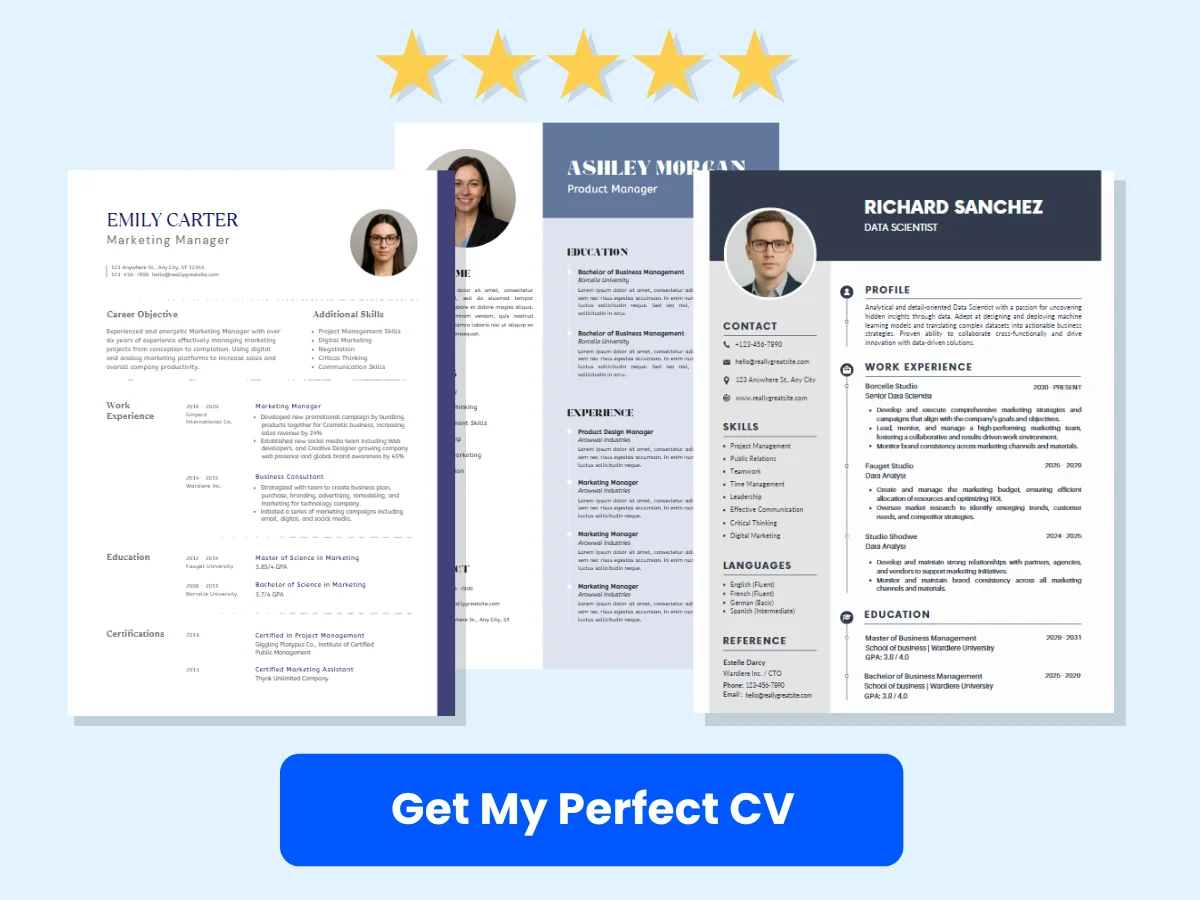In the competitive landscape of education, a well-crafted CV can be the key to unlocking your dream math teaching position. As a math teacher, your ability to convey complex concepts with clarity and enthusiasm is essential—not just in the classroom, but also on paper. A standout CV not only showcases your qualifications and experience but also reflects your passion for teaching and your commitment to student success.
This article delves into the intricacies of creating an effective math teacher CV, providing you with five expert examples that illustrate best practices and innovative approaches. Whether you are a seasoned educator or just starting your career, you will discover valuable insights into tailoring your CV to highlight your unique strengths, skills, and achievements. From formatting tips to essential content elements, we aim to equip you with the tools necessary to make a lasting impression on hiring committees.
Join us as we explore the art of crafting a compelling math teacher CV that not only stands out but also opens doors to new opportunities in the field of education.
Exploring the Basics of a Math Teacher CV
Key Components of a CV
Creating a compelling CV is essential for any math teacher looking to secure a position in an educational institution. A well-structured CV not only highlights your qualifications and experience but also showcases your teaching philosophy and approach to mathematics education. Here are the key components that should be included in a math teacher CV:
- Contact Information: Start with your full name, phone number, email address, and LinkedIn profile (if applicable). Ensure that your email address is professional.
- Professional Summary: This is a brief section (2-3 sentences) that summarizes your teaching experience, areas of expertise, and what you bring to the role. Tailor this to reflect your passion for mathematics and education.
- Education: List your degrees in reverse chronological order. Include the name of the institution, degree obtained, and graduation date. If you have a specialization in mathematics or education, be sure to highlight it.
- Teaching Certifications: Include any relevant teaching certifications or licenses. This may include state certifications, endorsements in mathematics, or specialized training in educational methodologies.
- Professional Experience: Detail your teaching experience, starting with the most recent position. For each role, include the school name, location, your job title, and the dates of employment. Use bullet points to describe your responsibilities and achievements, focusing on your contributions to student learning and engagement.
- Skills: Highlight both hard and soft skills relevant to teaching mathematics. This may include proficiency in specific mathematical software, classroom management techniques, and communication skills.
- Professional Development: List any workshops, conferences, or courses you have attended that are relevant to mathematics education. This shows your commitment to continuous learning and improvement.
- Publications and Presentations: If you have published articles or presented at conferences, include these in your CV. This can demonstrate your expertise and thought leadership in the field of mathematics education.
- References: It’s common to include references or state that they are available upon request. Choose individuals who can speak to your teaching abilities and character.
Differences Between a CV and a Resume
Understanding the distinction between a CV and a resume is crucial for math teachers, as it can affect how you present your qualifications. Here are the primary differences:


- Length: A CV is typically longer than a resume. While a resume is usually one page (or two at most), a CV can extend to several pages, especially for those with extensive experience and qualifications.
- Content: A CV provides a comprehensive overview of your academic and professional history, including detailed sections on education, teaching experience, research, publications, and professional development. In contrast, a resume is more concise and tailored to a specific job, focusing on relevant experience and skills.
- Purpose: CVs are often used in academic, research, and educational settings, while resumes are more common in the corporate world. For math teachers, a CV is typically the preferred document when applying for teaching positions, especially in higher education.
- Customization: While both documents should be tailored to the job you are applying for, resumes require more customization to highlight the most relevant experience for a specific position. CVs, on the other hand, are more static and comprehensive.
Common Mistakes to Avoid
When crafting your math teacher CV, it’s essential to avoid common pitfalls that can detract from your qualifications. Here are some mistakes to watch out for:
- Using a Generic Template: While templates can be helpful, relying too heavily on them can lead to a CV that lacks personalization. Ensure that your CV reflects your unique experiences and teaching philosophy.
- Neglecting to Tailor Your CV: Failing to customize your CV for each application can be detrimental. Highlight the skills and experiences that are most relevant to the specific position you are applying for.
- Overloading with Jargon: While it’s important to demonstrate your expertise, using too much technical jargon can alienate readers. Aim for clarity and accessibility, especially if your CV will be reviewed by non-mathematics educators.
- Ignoring Formatting: A cluttered or poorly formatted CV can be difficult to read. Use clear headings, bullet points, and consistent font styles to enhance readability. Ensure that your CV is visually appealing and professional.
- Omitting Key Achievements: Don’t just list your responsibilities; highlight your accomplishments. Use quantifiable metrics where possible, such as improvements in student performance or successful implementation of new teaching strategies.
- Being Too Vague: Avoid vague statements that do not provide concrete examples of your skills and experiences. Instead, be specific about your contributions and the impact you had in your previous roles.
- Failing to Proofread: Spelling and grammatical errors can undermine your professionalism. Always proofread your CV multiple times and consider having a colleague review it as well.
By understanding the key components of a math teacher CV, recognizing the differences between a CV and a resume, and avoiding common mistakes, you can create a compelling document that effectively showcases your qualifications and sets you apart in the competitive field of education.
Crafting an Effective Math Teacher CV
Creating a compelling CV is essential for any math teacher looking to secure a position in a competitive educational landscape. A well-structured CV not only highlights your qualifications and experience but also showcases your passion for teaching and your ability to inspire students. Below, we delve into the key components of an effective math teacher CV, providing insights and examples to help you stand out.
Personal Information and Contact Details
Your CV should begin with your personal information and contact details, which should be clearly presented at the top of the document. This section should include:
- Full Name: Use your full name as it appears on official documents.
- Phone Number: Provide a reliable phone number where you can be reached.
- Email Address: Use a professional email address, ideally a combination of your name.
- Location: Include your city and state, but you do not need to provide your full address for privacy reasons.
Example:
John Doe (123) 456-7890 [email protected] New York, NY
Professional Summary or Objective
The professional summary or objective is a brief statement that summarizes your qualifications and career goals. This section should be tailored to the specific job you are applying for, highlighting your teaching philosophy, relevant experience, and what you can bring to the school or institution.


Professional Summary Example:
Dedicated and passionate Math Teacher with over 5 years of experience in fostering a positive learning environment for students. Proven track record of improving student performance through innovative teaching methods and personalized instruction. Committed to instilling a love for mathematics in students and preparing them for academic success.
Objective Example:
Enthusiastic and results-driven Math Teacher seeking to leverage expertise in curriculum development and student engagement at XYZ High School. Aiming to create a dynamic classroom environment that encourages critical thinking and problem-solving skills among students.
Education and Certifications
In this section, list your educational background, including degrees earned, institutions attended, and graduation dates. Additionally, include any relevant certifications that enhance your qualifications as a math teacher.
- Degree: Start with your highest degree first.
- Institution: Name the college or university.
- Graduation Date: Include the month and year of graduation.
- Certifications: List any teaching certifications, endorsements, or specialized training relevant to math education.
Example:
Master of Education in Mathematics University of New York, New York, NY Graduated: May 2018 Bachelor of Science in Mathematics University of California, Los Angeles, CA Graduated: May 2015 Certifications: - New York State Teaching Certification in Mathematics (Grades 7-12) - Advanced Placement (AP) Calculus Certification
Teaching Experience
Your teaching experience is one of the most critical sections of your CV. It should detail your previous positions, responsibilities, and achievements in a clear and concise manner. Use bullet points to make this section easy to read, and start each bullet with an action verb to convey your contributions effectively.


- Job Title: Include your title, such as “Math Teacher” or “Mathematics Instructor.”
- School Name: Provide the name of the institution where you worked.
- Location: Include the city and state.
- Dates of Employment: Specify the month and year you started and ended each position.
- Responsibilities and Achievements: Use bullet points to outline your key responsibilities and any notable achievements.
Example:
Math Teacher ABC High School, New York, NY August 2018 - Present - Developed and implemented engaging lesson plans for Algebra I and II, Geometry, and Pre-Calculus. - Utilized technology and interactive tools to enhance student learning and engagement. - Collaborated with fellow educators to design interdisciplinary projects that integrated math with science and art. - Achieved a 20% increase in student test scores on state assessments over two academic years. Math Instructor XYZ Middle School, Los Angeles, CA August 2015 - June 2018 - Taught 7th and 8th-grade mathematics, focusing on foundational skills and problem-solving techniques. - Created a supportive classroom environment that encouraged student participation and collaboration. - Organized after-school tutoring sessions, resulting in improved performance for struggling students.
Skills and Competencies
In this section, you should highlight the skills and competencies that make you an effective math teacher. This can include both hard skills (specific knowledge and abilities) and soft skills (interpersonal and communication skills). Tailor this section to reflect the requirements of the job you are applying for.
- Hard Skills:
- Proficient in using educational technology and software (e.g., Smartboards, Google Classroom, Math software).
- Strong knowledge of mathematics curriculum standards and assessment methods.
- Ability to analyze and interpret data to inform instruction.
- Soft Skills:
- Excellent communication and interpersonal skills, fostering positive relationships with students and parents.
- Strong organizational and time management abilities, effectively balancing multiple responsibilities.
- Adaptability and creativity in developing lesson plans that cater to diverse learning styles.
Example:
Skills: - Proficient in educational technology (Smartboards, Google Classroom) - Strong knowledge of Common Core Standards - Excellent communication and interpersonal skills - Creative lesson planning and curriculum development - Data analysis for student performance improvement
By carefully crafting each section of your math teacher CV, you can effectively showcase your qualifications and passion for teaching mathematics. Remember to tailor your CV for each application, emphasizing the skills and experiences that align with the specific job requirements. A well-organized and thoughtfully presented CV will help you make a strong impression on potential employers and increase your chances of landing your desired teaching position.
Highlighting Your Achievements and Contributions
When crafting a CV as a math teacher, it’s essential to go beyond listing your qualifications and responsibilities. Highlighting your achievements and contributions can set you apart from other candidates and demonstrate your effectiveness in the classroom. This section will delve into how to quantify your impact, include relevant projects and initiatives, and showcase awards and recognitions that can enhance your CV.
Quantifying Your Impact
One of the most effective ways to highlight your achievements is by quantifying your impact. Numbers and statistics provide concrete evidence of your contributions and can make your CV more compelling. Here are some strategies to effectively quantify your achievements:
- Student Performance Metrics: Include data that reflects your students’ performance improvements. For example, you might state, “Increased student test scores by 20% over two academic years” or “Achieved a 95% pass rate in standardized math assessments.” These figures not only demonstrate your teaching effectiveness but also your ability to foster student success.
- Classroom Engagement: If you implemented new teaching strategies or technologies that improved student engagement, quantify that impact. For instance, “Implemented a flipped classroom model that resulted in a 30% increase in student participation during lessons.”
- Curriculum Development: If you developed or contributed to a curriculum, specify the outcomes. For example, “Designed a new algebra curriculum that improved student comprehension scores by 15% in the first year of implementation.”
- Extracurricular Involvement: If you led math clubs or tutoring programs, quantify the number of students involved or the hours dedicated. For instance, “Coordinated a math tutoring program that supported over 50 students weekly, resulting in a 40% increase in their overall math grades.”
By incorporating these quantifiable achievements into your CV, you provide potential employers with clear evidence of your capabilities and the positive impact you have had on your students and school community.


Including Relevant Projects and Initiatives
In addition to quantifying your impact, it’s important to include specific projects and initiatives that showcase your skills and commitment to education. These can be classroom projects, community outreach programs, or innovative teaching methods you’ve implemented. Here are some examples of how to effectively present these initiatives:
- Project-Based Learning: If you have led project-based learning initiatives, describe the project, your role, and the outcomes. For example, “Led a project-based learning initiative where students created a math-based business plan, resulting in enhanced critical thinking skills and real-world application of mathematical concepts.”
- Technology Integration: Highlight any technology initiatives you’ve spearheaded. For instance, “Introduced the use of interactive math software in the classroom, which improved student engagement and understanding of complex concepts, as evidenced by a 25% increase in homework completion rates.”
- Community Engagement: If you have organized community events or partnerships, detail these experiences. For example, “Coordinated a math fair that involved over 200 students and parents, fostering a love for mathematics and community involvement.”
- Professional Development Initiatives: If you have taken the initiative to lead professional development workshops for fellow teachers, mention these experiences. For example, “Facilitated a workshop on differentiated instruction in math, attended by 30 educators, which resulted in improved teaching strategies across the department.”
Including these projects and initiatives not only highlights your proactive approach to teaching but also demonstrates your ability to innovate and inspire both students and colleagues.
Showcasing Awards and Recognitions
Recognition from peers, administrators, or educational organizations can significantly enhance your CV. Awards and honors serve as third-party validation of your skills and contributions. Here’s how to effectively showcase these accolades:
- Teaching Awards: If you have received any teaching awards, be sure to include them. For example, “Recipient of the ‘Outstanding Math Teacher Award’ from the State Education Association in 2022 for exceptional contributions to student learning.”
- Grants and Scholarships: If you have secured grants for educational projects or scholarships for students, mention these achievements. For instance, “Awarded a $5,000 grant for developing a STEM program that increased student interest in mathematics and science.”
- Professional Affiliations: Membership in professional organizations can also be a point of recognition. For example, “Active member of the National Council of Teachers of Mathematics (NCTM), contributing to national discussions on math education best practices.”
- Publications and Presentations: If you have published articles or presented at conferences, include these as well. For instance, “Presented research on effective math teaching strategies at the National Math Conference, 2023, which was well-received by educators nationwide.”
When listing awards and recognitions, be sure to include the name of the award, the awarding body, and the date received. This information adds credibility and context to your achievements.
Formatting Your Achievements
When incorporating your achievements and contributions into your CV, consider the following formatting tips to ensure clarity and readability:
- Use Bullet Points: Bullet points make it easier for hiring managers to scan your CV quickly. Each bullet should start with a strong action verb and be concise.
- Prioritize Relevance: Tailor your achievements to the specific job you are applying for. Highlight those that align most closely with the job description and the school’s mission.
- Organize by Category: Consider organizing your achievements into categories such as “Teaching Achievements,” “Projects and Initiatives,” and “Awards and Recognitions” to create a clear structure.
- Keep It Concise: While it’s important to provide detail, aim to keep each bullet point to one or two lines to maintain readability.
By effectively highlighting your achievements and contributions, you can create a compelling CV that showcases your strengths as a math teacher. Remember, your CV is not just a list of your experiences; it’s a narrative of your professional journey and the impact you’ve made in the field of education.


Tailoring Your CV for Different Roles
Creating a standout CV as a math teacher requires more than just listing your qualifications and experience. It involves tailoring your CV to fit the specific role you are applying for. Different educational environments and grade levels have unique expectations and requirements. We will explore how to adapt your CV for elementary, middle, and high school positions, customize it for private versus public schools, and address specific job descriptions effectively.
Adapting for Elementary, Middle, and High School Positions
When applying for teaching positions at different educational levels, it’s crucial to understand the distinct needs and expectations of each age group. Here’s how to tailor your CV for elementary, middle, and high school positions:
Elementary School Positions
Elementary school teachers play a vital role in laying the foundation for students’ future learning. When crafting your CV for an elementary school position, emphasize your ability to create a nurturing and engaging learning environment. Here are some key points to include:
- Focus on Early Childhood Education: Highlight any certifications or coursework in early childhood education. Mention specific strategies you use to teach foundational math concepts, such as hands-on activities or games.
- Classroom Management Skills: Discuss your approach to classroom management, emphasizing techniques that foster a positive and inclusive atmosphere.
- Collaboration with Parents: Include experiences where you engaged with parents to support their children’s learning, such as organizing parent-teacher conferences or workshops.
- Integration of Technology: Mention any experience using educational technology to enhance math instruction, such as interactive whiteboards or math software.
Middle School Positions
Middle school teachers often face the challenge of bridging the gap between elementary and high school education. Your CV should reflect your ability to engage students in more complex mathematical concepts while still addressing their developmental needs:
- Curriculum Development: Highlight your experience in developing and implementing math curricula that align with state standards and cater to diverse learning styles.
- Student Engagement: Provide examples of how you have successfully engaged students in math through project-based learning or real-world applications.
- Assessment Strategies: Discuss your approach to assessing student understanding, including formative and summative assessments, and how you use data to inform instruction.
- Collaboration with Colleagues: Mention any collaborative projects with other teachers, such as interdisciplinary units that integrate math with science or art.
High School Positions
High school math teachers prepare students for college and careers, so your CV should reflect your expertise in advanced mathematical concepts and your ability to inspire students:
- Advanced Coursework: List any advanced math courses you are qualified to teach, such as calculus, statistics, or algebra II. Include any relevant certifications.
- Real-World Applications: Provide examples of how you connect math to real-world scenarios, such as financial literacy or engineering principles.
- Mentorship and Leadership: Highlight any roles you have taken on as a mentor or leader within the school, such as leading math clubs or tutoring programs.
- Professional Development: Mention any ongoing professional development related to math education, such as workshops, conferences, or advanced degrees.
Customizing for Private vs. Public Schools
When applying for positions in private versus public schools, it’s essential to understand the differences in their educational philosophies, curricula, and student demographics. Here’s how to customize your CV for each type of institution:


Private Schools
Private schools often have more flexibility in their curricula and may emphasize a particular educational philosophy. When applying to a private school, consider the following:
- Philosophy Alignment: Research the school’s mission and values. Tailor your CV to reflect how your teaching philosophy aligns with theirs, whether it’s Montessori, Waldorf, or another approach.
- Innovative Teaching Methods: Highlight any innovative teaching methods you have employed, such as project-based learning or differentiated instruction, which may resonate with private school values.
- Extracurricular Involvement: Mention any extracurricular activities you can contribute to, such as math clubs, tutoring programs, or community service initiatives.
- Parent Engagement: Discuss your experience in fostering strong relationships with parents, as private schools often emphasize community involvement.
Public Schools
Public schools typically adhere to state standards and regulations. When applying to a public school, focus on the following:
- Compliance with Standards: Emphasize your knowledge of state standards and how you have successfully implemented them in your teaching.
- Diverse Student Populations: Highlight your experience working with diverse student populations and your ability to differentiate instruction to meet varied learning needs.
- Collaboration with Staff: Discuss your experience collaborating with other educators and staff to enhance the educational experience for students.
- Data-Driven Instruction: Provide examples of how you use data to inform your teaching practices and improve student outcomes.
Addressing Specific Job Descriptions
Each job description will have unique requirements and preferences. To make your CV stand out, it’s essential to address these specifics directly:
- Keywords from the Job Description: Carefully read the job description and identify keywords and phrases that are emphasized. Incorporate these into your CV to demonstrate that you meet the employer’s needs.
- Highlight Relevant Experience: Tailor your work experience section to emphasize roles and responsibilities that align with the job description. Use bullet points to clearly outline your achievements and contributions.
- Showcase Relevant Skills: If the job description mentions specific skills, such as proficiency in educational technology or experience with special education, ensure these are prominently featured in your CV.
- Personalize Your Objective Statement: Craft a personalized objective statement that reflects your enthusiasm for the specific role and how your background makes you a strong candidate.
By taking the time to tailor your CV for different roles, you not only demonstrate your qualifications but also show potential employers that you understand their unique needs and are committed to meeting them. This strategic approach can significantly enhance your chances of landing an interview and ultimately securing the position you desire.
Expert Examples of Math Teacher CVs
Crafting a compelling CV is essential for any math teacher looking to secure a position in the competitive education sector. Below, we present five expert examples of Math Teacher CVs tailored to different career stages and teaching environments. Each example is designed to highlight the unique skills and experiences relevant to the specific role, ensuring that candidates can effectively showcase their qualifications.
Example 1: Entry-Level Math Teacher CV
Jane Doe
123 Maple Street
Springfield, IL 62701
(555) 123-4567
[email protected]


Objective
Enthusiastic and dedicated recent graduate with a Bachelor’s degree in Mathematics Education seeking an entry-level position as a Math Teacher at Springfield High School. Passionate about fostering a positive learning environment and helping students develop a love for mathematics.
Education
- Bachelor of Science in Mathematics Education
University of Illinois, Urbana-Champaign, IL
Graduated: May 2023
Certifications
- Illinois Professional Educator License (PEL)
- CPR and First Aid Certified
Teaching Experience
- Student Teacher
Lincoln Middle School, Springfield, IL
January 2023 – May 2023- Developed and implemented engaging lesson plans for 7th and 8th-grade math classes.
- Utilized technology to enhance learning, including interactive math software and online resources.
- Assisted in the organization of math competitions and after-school tutoring sessions.
Skills
- Strong knowledge of algebra, geometry, and calculus
- Proficient in educational technology and online learning platforms
- Excellent communication and interpersonal skills
Example 2: Experienced Math Teacher CV
John Smith
456 Oak Avenue
Chicago, IL 60601
(555) 987-6543
[email protected]
Objective
Results-driven math educator with over 10 years of experience in teaching high school mathematics. Seeking to leverage expertise in curriculum development and student engagement at Chicago Central High School to enhance student performance and foster a love for mathematics.
Education
- Master of Education in Curriculum and Instruction
DePaul University, Chicago, IL
Graduated: May 2015 - Bachelor of Science in Mathematics
University of Chicago, Chicago, IL
Graduated: May 2012
Certifications
- Illinois Professional Educator License (PEL)
- National Board Certified Teacher (NBCT)
Teaching Experience
- Math Teacher
Lincoln High School, Chicago, IL
August 2012 – Present- Designed and implemented a comprehensive math curriculum for grades 9-12, focusing on algebra, geometry, and statistics.
- Increased student test scores by 20% through innovative teaching methods and personalized learning plans.
- Mentored new teachers and provided professional development workshops on effective math instruction.
Skills
- Expertise in differentiated instruction and assessment
- Strong leadership and mentoring abilities
- Proficient in data analysis and using assessment tools to track student progress
Example 3: Math Teacher CV for Private Schools
Emily Johnson
789 Pine Road
Evanston, IL 60201
(555) 321-0987
[email protected]
Objective
Dedicated and innovative math teacher with a passion for teaching in a private school setting. Seeking a position at St. Mary’s Academy to inspire students and cultivate a strong foundation in mathematics through personalized instruction and creative problem-solving.
Education
- Bachelor of Arts in Mathematics
Northwestern University, Evanston, IL
Graduated: May 2020
Certifications
- Illinois Professional Educator License (PEL)
- Certified in Gifted Education
Teaching Experience
- Math Teacher
Greenfield Academy, Evanston, IL
August 2020 – Present- Developed a project-based learning curriculum that integrates real-world applications of mathematics.
- Facilitated small group instruction to support diverse learning needs and foster critical thinking skills.
- Organized math enrichment programs and collaborated with faculty to enhance interdisciplinary learning.
Skills
- Strong background in project-based and inquiry-based learning
- Ability to create a nurturing and inclusive classroom environment
- Excellent organizational and communication skills
Example 4: Math Teacher CV with Administrative Experience
Michael Brown
101 Birch Lane
Naperville, IL 60540
(555) 654-3210
[email protected]
Objective
Dynamic math educator with over 15 years of teaching experience and 5 years in administrative roles. Seeking a leadership position at Naperville North High School to drive academic excellence and foster a collaborative environment among faculty and students.
Education
- Master of Arts in Educational Leadership
University of Illinois, Chicago, IL
Graduated: May 2018 - Bachelor of Science in Mathematics Education
Illinois State University, Normal, IL
Graduated: May 2007
Certifications
- Illinois Professional Educator License (PEL)
- Administrative Certificate
Teaching Experience
- Math Department Chair
Naperville Central High School, Naperville, IL
August 2015 – Present- Led a team of 10 math teachers in curriculum development and instructional strategies.
- Implemented data-driven decision-making processes to improve student outcomes.
- Organized professional development workshops focused on innovative teaching practices.
- Math Teacher
Naperville Central High School, Naperville, IL
August 2007 – June 2015- Taught a variety of math courses, including AP Calculus and Statistics.
- Developed and implemented engaging lesson plans that catered to diverse learning styles.
Skills
- Strong leadership and team-building skills
- Expertise in curriculum design and assessment
- Proficient in educational technology and data analysis
Example 5: Math Teacher CV for Online Teaching Positions
Sarah Wilson
202 Cedar Street
Remote, IL 60000
(555) 987-1234
[email protected]
Objective
Innovative and tech-savvy math teacher with 8 years of experience in both traditional and online education. Seeking a position as an Online Math Teacher with Virtual Learning Academy to leverage my skills in creating engaging virtual learning experiences for students.
Education
- Bachelor of Science in Mathematics Education
University of Southern California, Los Angeles, CA
Graduated: May 2015
Certifications
- Illinois Professional Educator License (PEL)
- Online Teaching Certification
Teaching Experience
- Online Math Teacher
Virtual Learning Academy, Remote
August 2018 – Present- Designed and delivered engaging online math courses for grades 6-12 using various digital platforms.
- Utilized interactive tools and resources to enhance student engagement and understanding.
- Provided individualized support and feedback to students through virtual office hours and discussion forums.
- Math Teacher
Lincoln High School, Chicago, IL
August 2015 – June 2018- Taught a range of math courses, including Algebra I, Geometry, and Pre-Calculus.
- Incorporated technology into the classroom to facilitate collaborative learning.
Skills
- Proficient in online teaching platforms (Zoom, Google Classroom, Canvas)
- Strong ability to create interactive and engaging digital content
- Excellent communication and organizational skills
Formatting and Design Tips
Choosing the Right CV Template
When it comes to crafting a compelling CV for a math teacher position, the template you choose can significantly impact the first impression you make on hiring committees. A well-structured CV not only showcases your qualifications but also reflects your professionalism and attention to detail. Here are some key considerations for selecting the right CV template:
- Professionalism: Opt for a template that conveys professionalism. Avoid overly decorative designs that may distract from the content. A clean, minimalist layout with clear headings and ample white space is often the best choice.
- Readability: Ensure that the font size and style are easy to read. Common choices include Arial, Calibri, or Times New Roman in sizes 10-12. The use of bold for headings and subheadings can help guide the reader’s eye.
- Customization: Choose a template that allows for customization. You want to be able to adjust sections to highlight your strengths, such as teaching experience, certifications, and educational background.
- ATS Compatibility: Many organizations use Applicant Tracking Systems (ATS) to filter CVs. Select a template that is ATS-friendly, meaning it should avoid complex formatting, graphics, and unusual fonts that may confuse the software.
There are numerous resources available online where you can find free or paid CV templates specifically designed for educators. Websites like Canva, Microsoft Word, and Google Docs offer a variety of options that can be tailored to your needs.
Best Practices for Layout and Design
The layout and design of your CV are crucial in ensuring that your qualifications are presented clearly and effectively. Here are some best practices to follow:
- Use Clear Headings: Organize your CV into distinct sections with clear headings such as “Education,” “Teaching Experience,” “Certifications,” and “Skills.” This helps hiring managers quickly locate the information they need.
- Consistent Formatting: Maintain consistency in formatting throughout your CV. Use the same font style and size for similar elements, such as job titles and dates. This creates a cohesive look that is visually appealing.
- Bullet Points for Clarity: Use bullet points to list your responsibilities and achievements under each position. This format makes it easier for readers to scan your CV and absorb the information quickly.
- Limit Length: Aim to keep your CV to one or two pages. While it’s important to include relevant information, being concise is key. Focus on the most impactful experiences and skills that align with the job you are applying for.
- Include Contact Information: At the top of your CV, include your name, phone number, email address, and LinkedIn profile (if applicable). Make sure this information is easy to find and read.
- Highlight Key Achievements: Use bold or italics to emphasize key achievements or qualifications. This draws attention to your most impressive accomplishments and can make a lasting impression.
Remember, the goal of your CV is to present your qualifications in a way that is both informative and engaging. A well-organized layout can help you achieve this goal.
Using Action Verbs and Keywords
Incorporating action verbs and relevant keywords into your CV is essential for making your application stand out. Action verbs convey a sense of proactivity and accomplishment, while keywords ensure that your CV aligns with the job description and can pass through ATS filters. Here’s how to effectively use both:
Action Verbs
Action verbs are powerful tools that can enhance the impact of your CV. They help to convey your contributions and achievements in a dynamic way. Here are some effective action verbs to consider:
- Developed: Use this verb to describe curriculum development or lesson planning.
- Implemented: This is ideal for showcasing new teaching strategies or classroom management techniques you have introduced.
- Facilitated: Use this when discussing your role in guiding discussions or group activities.
- Assessed: This verb is useful for highlighting your experience in evaluating student performance or program effectiveness.
- Collaborated: This can demonstrate your ability to work with colleagues, parents, or the community.
- Mentored: Use this to showcase your experience in guiding or supporting other teachers or students.
By using these action verbs, you can create a more engaging narrative about your professional experiences and contributions.
Keywords
In addition to action verbs, incorporating relevant keywords from the job description is crucial. This not only helps your CV resonate with hiring managers but also increases the chances of passing through ATS filters. Here are some tips for effectively using keywords:
- Analyze the Job Description: Carefully read the job posting and identify key skills, qualifications, and responsibilities mentioned. Make a list of these keywords.
- Integrate Keywords Naturally: Incorporate these keywords into your CV in a way that feels natural. For example, if the job description emphasizes “differentiated instruction,” ensure that this phrase appears in your teaching philosophy or experience sections.
- Focus on Relevant Skills: Highlight skills that are particularly relevant to the position, such as “data analysis,” “curriculum design,” or “classroom technology integration.”
- Use Variations: Consider using variations of keywords to cover different aspects of your experience. For instance, if “student engagement” is a keyword, you might also mention “student participation” or “active learning strategies.”
By strategically using action verbs and keywords, you can create a compelling CV that effectively communicates your qualifications and aligns with the expectations of hiring committees.
The formatting and design of your math teacher CV play a crucial role in how your qualifications are perceived. By choosing the right template, adhering to best practices for layout and design, and utilizing action verbs and keywords effectively, you can create a CV that stands out in a competitive job market. Remember, your CV is often the first impression you make on potential employers, so invest the time and effort to make it as polished and professional as possible.
Proofreading and Finalizing Your CV
Creating a standout CV is a crucial step in securing a position as a math teacher. However, the work doesn’t end once you’ve drafted your CV. Proofreading and finalizing your document is just as important to ensure that it presents you in the best possible light. This section will guide you through essential proofreading tips, the importance of seeking feedback from peers, and a final checklist to ensure your CV is polished and ready for submission.
Common Proofreading Tips
Proofreading is the process of reviewing your CV to identify and correct errors in grammar, punctuation, spelling, and formatting. Here are some common proofreading tips to help you refine your document:
- Take a Break: After finishing your CV, step away from it for a few hours or even a day. This break will help you return with fresh eyes, making it easier to spot mistakes.
- Read Aloud: Reading your CV out loud can help you catch awkward phrasing and errors that you might overlook when reading silently. This technique also allows you to hear how your CV flows.
- Print It Out: Sometimes, errors are easier to spot on paper than on a screen. Print your CV and review it in a different format to catch any mistakes.
- Check for Consistency: Ensure that your formatting is consistent throughout the document. This includes font sizes, bullet points, and spacing. Consistency reflects professionalism.
- Focus on Common Errors: Be aware of common mistakes, such as mixing up “their,” “there,” and “they’re,” or using “affect” instead of “effect.” Familiarize yourself with your frequent errors and pay special attention to them.
- Use Tools: Utilize grammar and spell-check tools like Grammarly or Hemingway to catch errors. However, don’t rely solely on these tools; they may not catch every mistake.
Seeking Feedback from Peers
Once you’ve proofread your CV, it’s beneficial to seek feedback from peers or mentors. Getting a second opinion can provide valuable insights and help you identify areas for improvement. Here’s how to effectively seek feedback:
- Choose the Right People: Select individuals who have experience in education or hiring. This could be fellow teachers, administrators, or career advisors who understand what schools look for in a math teacher.
- Be Specific: When asking for feedback, be specific about what you want them to focus on. For example, you might ask them to evaluate the clarity of your teaching philosophy or the effectiveness of your accomplishments section.
- Be Open to Criticism: Accept feedback graciously, even if it’s not what you want to hear. Constructive criticism can help you improve your CV significantly.
- Incorporate Suggestions: After receiving feedback, take the time to incorporate relevant suggestions into your CV. This may involve rephrasing sections, adding details, or removing unnecessary information.
- Follow Up: After making changes based on feedback, consider sharing the revised version with the same peers for additional input. This iterative process can lead to a more polished final product.
Final Checklist Before Submission
Before you submit your CV, it’s essential to conduct a final review to ensure everything is in order. Here’s a comprehensive checklist to guide you:
- Contact Information: Verify that your contact information is accurate and up-to-date. Include your name, phone number, email address, and LinkedIn profile if applicable.
- Tailored Content: Ensure that your CV is tailored to the specific job you are applying for. Highlight relevant experiences and skills that align with the job description.
- Professional Formatting: Check that your CV is professionally formatted. Use clear headings, bullet points, and consistent font styles. Avoid excessive colors or graphics that may distract from the content.
- Length: Aim for a CV length of one to two pages. Be concise and focus on the most relevant information. If your CV exceeds two pages, consider trimming less critical details.
- Achievements and Impact: Highlight your achievements and the impact you’ve made in previous roles. Use quantifiable metrics where possible, such as “increased student test scores by 20%” or “implemented a new curriculum that improved student engagement.
- References: Decide whether to include references on your CV or state that they are available upon request. If you include them, ensure that you have permission from your references.
- Final Proofread: Conduct one last proofread to catch any lingering errors. Pay attention to formatting, grammar, and spelling one final time.
- File Format: Save your CV in a professional format, such as PDF, to preserve the formatting. Ensure the file name is clear and professional, such as “John_Doe_Math_Teacher_CV.pdf.”
- Submission Guidelines: Review the submission guidelines for the job application. Ensure that you follow any specific instructions regarding file format, length, and additional documents required.
By following these proofreading and finalization steps, you can ensure that your math teacher CV is polished, professional, and ready to make a strong impression on potential employers. A well-crafted CV not only showcases your qualifications but also reflects your attention to detail and commitment to excellence in education.








